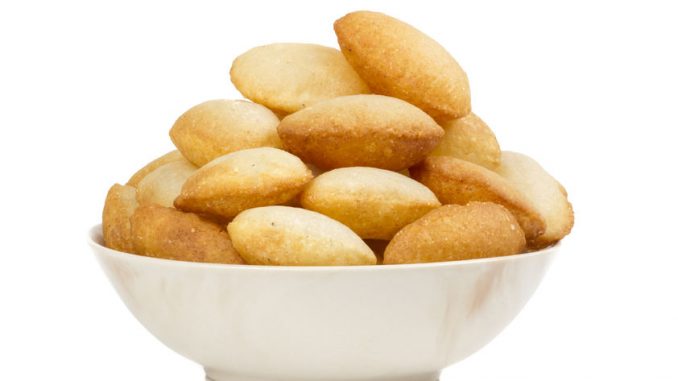
The classic street food of India must be the pani puri although I’ve started with just one of its many names. In some places the name is more phonetic as in ‘poorie’. To many of us these are delicious crispy puris made from semolina flour and filled with all sorts of good things from a masala to mint leaves and other delicious ingredients. They are a deep-fried bread that does not need any leavening.
Imagine a baking hot afternoon on Delhi rather than a soaking wet morning in Manchester. These puris are a real treat and I dunk them in chutney – usually a tamarind one.
In other parts of India they are known as ‘gol gappas’ as in northern India or ‘Poochkas’ as in West Bengal and parts of Pakistan and Nepal too. Many commentators believe they are of Bangladeshi origin and they probably are not Indian in truth – they do have their own quality breads to hail after all. The term puri derives from a Sanskrit word ‘pura’ which means filled. These are used like rotis and chapatis with curries.

I know people fill them with cabbage and sprouts but some cooks prefer hot ragda. They also go well with Tikki and Chaat (Chat) on a deli plate. I know there are many ways to make them and we have an alternative version for the pani puri too.
Producing puris needs practice as I have found it depends in part on the flour. They need to be stored in an air-tight container and last for up to 3 weeks. To recover their crispiness, I rebake them for up to 5 minutes in an oven at 90 Centigrade but don’t overdo this.
Preparation Time: 20 to 30 minutes: Cooking Time: 15 to 20 minutes: Serves: 4 but 6 is also feasible. Here we make 20 golgappas (puris) but the amounts can be halved for 10 of course.
[Please note we are an affiliate marketing partner and will make a sales commission if you purchase any items through our affiliate links. Please read our affiliate disclosure].
Ingredients
The Puri
- 1/2 cup semolina (rava/sooji)
- 1/2 tbsp plain flour (maida is an Indian flour otherwise it is strong white in the UK. I have tried Italian ‘00’ which makes for a hard puri and is not bad for that).
- salt as required
- 1/4 cup chilled soda
- Vegetable oil for deep-frying (not olive oil)
Preparation
- Mix the semolina, flour, baking soda and salt in large bowl.
- Add water in small amounts to create a dough which must be stiff when it is rounded.
- Leave in the bowl for 25 minutes and cover with a damp cloth
- After this time and really not before, just knead the dough to a smooth texture.
- Divide this dough into 4 roughly equal portions.
- Each portion is shaped into a ball. Press each one between the palms of the hands and begin to flatten.
- Use a rolling pin to create what is in effect a roti. Some recipes suggest it should have the thickness of a chapatti (chapathi) which is about 2 mm. It should not be rolled to think or thin but it is a matter of taste in my view having seen my colleagues roll it out like a pizza dough. Too thin and it does not puff up when being fried. Too thick and it really wont crisp up in the fryer either. It takes practice hence the warning for patience !
- Round and small puris are made using a cutting mould of about 2.5 inches although you can get away with 2 inch moulds.
- Continue to make more puris with any spare dough.
- Heat vegetable oil in a deep frying pan or a chip fryer for deep frying. Get it to the sort of temperature needed for any dough product including doughnuts let us say.
- When oil is medium hot, take 5-6 puris and slide them gently in oil but do not drop them all together as they stick. Press each puri just a small amount with a spatula to make them puff up. Deep fry them until crispy and light golden brown.
- Remove and place them on paper napkin to absorb extra oil.
If you are interested in developing refined fillings then I would recommend going with a prawn puri which is super starter for most Indian dinners.

Leave a Reply